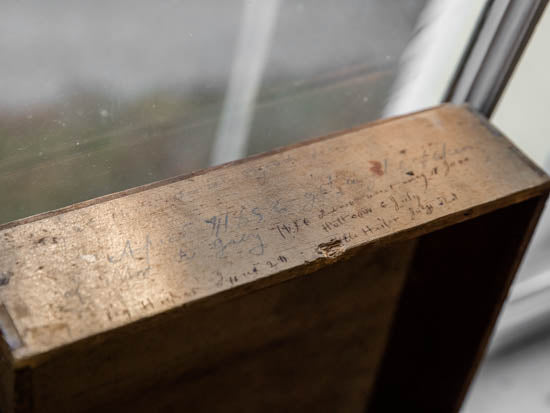
One of the most exciting aspects of working with old handmade objects is deciphering the stories told by tool marks. An undercut here, some traversing there - these can give great insight into the thought process of the craftsman who first handled these pieces of wood centuries ago. But the language written by old bits of tool steel can be mysterious and inexact - our familiar rules of grammar don't apply. How do you ask, "Did you use a template?" in Old Dovetail? Or, "What's with that drawer bottom?" in Rough Hatchet? It can be a great exercise in forensics trying to solve these very, very cold cases.
Occasionally, a piece will contain a much clearer form of communication from across the centuries. I'm talking about actual handwriting. Sometimes it's little more than doodled graffiti (see the sweet Queen Anne table featured in Issue #2). I imagine some young lad disappearing under Mother's favorite piece of furniture with the quill and inkwell and a mischievous look...), sometimes it's a signature of the maker or of ownership, and sometimes it's an even more profound link to the past.
I saw many of the latter recently at the Jonathan Fisher house, helping Joshua with some photography for his upcoming book. Fisher had an uncanny understanding of the timeless, and I got the sense that many of his creations were intended to communicate some truth to generations beyond his own lifespan. This sense of timelessness can be felt throughout the house. His molding planes, stamped with his name and year he made them (most in the 1790s), can be matched perfectly to molding profiles throughout the house. Most interesting, though, are the various notes left on and inside pieces of furniture that Fisher made. Notes about debts paid and owed (often settled in oats or livestock). Notes about illnesses and visitors, intense winter storms, and work accomplished. My favorite was found written on the side of a drawer in a quaint occasional table. Amidst other notes is one, likely penned by Fisher's son, that reads "May 28, 1885- John Clough work planting potatoes".

It is wonderful and quirky and a little odd that such events were written down on the interior bits of these lovely pieces of furniture... but I am definitely adopting the practice, if for no other reason than to give future generations something to scratch their heads over. And when you see your youngster disappear under the table with a marker in hand and a mischievous look, maybe you should just let them be. For posterity's sake.
~Mike Updegraff


